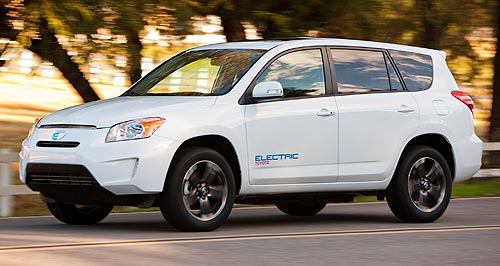Future models - Toyota - RAV4 - EVLA show: Toyota unwraps electric RAV4Power on: Toyota claims its prototype RAV4 EV, which uses a lithium metal oxide battery, can comfortably manage 160km across a range of conditions before requiring a recharge. Toyota targets 160km range with Tesla-powered RAV4 EV as development continues18 Nov 2010 By TERRY MARTIN TOYOTA has used this week’s Los Angeles auto show to unveil its all-new Tesla-powered RAV4 electric vehicle, which is claimed to have similar acceleration as the conventional version of the compact SUV while offering no tailpipe emissions and a driving range of around 160km. In presenting what is the second-generation RAV4 EV, after an electric version of the original RAV was built between 1996 and 2003, Toyota said 35 vehicles would be produced for demonstration and evaluation purposes in 2011, with a North American market introduction set down for 2012. At this stage, there is no timetable for the vehicle to be sold in Australia.  As expected, the electrified RAV has only minor exterior and interior design modifications over the combustion-engine version, with the sheetmetal left untouched and the changes limited to a revised front bumper, grille, headlights and foglights, plus a ‘mutually exclusive’ paint colour. As expected, the electrified RAV has only minor exterior and interior design modifications over the combustion-engine version, with the sheetmetal left untouched and the changes limited to a revised front bumper, grille, headlights and foglights, plus a ‘mutually exclusive’ paint colour.The interior has unique seat trim, a push-button gearshift and specific dashboard meters and multimedia displays. Toyota says no cargo space was lost in the conversion to an electric powertrain. Toyota Motor Sales USA president Jim Lentz admitted that the partnership with Tesla Motors, which with its Lotus Elise-based Roadster and its forthcoming Model S sedan has become one of the biggest names in the EV industry, was designed to bring full-electric models to market as quickly as possible. However, he emphasised that the fast-tracked development would not compromise product quality, which has come under intense pressure this year after a string of global recalls across a range of vehicles, including eco-oriented models such as the Toyota Prius. “Led by our Toyota technical centre in Michigan, (the RAV4 EV) is a model that has helped reduce development time without compromising product quality,” Mr Lentz said. “They have accomplished this by approaching this project as they would a mid-cycle ‘major-minor’ product change. To be more specific, midway through a generation we begin with a fully engineered current-generation RAV4 to which we are adding a major powertrain option, along with minor feature and cosmetic changes. “The vehicle on stage is not only a strong product on its own, it represents a point-in-time in both the business relationship and the product development, aiming to bring a vehicle to market in 2012.” Mr Lentz said the development team was currently engaged in the initial testing, validation and certification process, dubbed ‘Phase Zero’, which includes the demonstration program running through most of next year. “While Phase Zero vehicles are basically converted RAV4s, the ‘Phase One’ vehicles we plan to bring to market in 2012 will be thoroughly re-engineered Toyota RAV4 EVs,” he said. Detailed technical specifications remain under wraps for the Tesla-powered RAV4, but Toyota did reveal that the Phase Zero vehicle is powered by a lithium metal oxide battery with useable output rated in the mid-30kWh range. Mr Lentz said in his presentation that the Phase Zero vehicle “is consistently achieving a 100-mile (160km) range based on actual road driving patterns in a wide range of climates and conditions”. He said this was critical in achieving an “acceptable level of daily convenience” for vehicle owners, but added that the final driving range of the production vehicle would depend on “many factors still being considered, not the least of which is battery size and design as it relates to useable power”. These factors include extreme heat and cold weather conditions and the substantial effect they have on battery performance, and as such the initial sales distribution of the vehicle in the US will be restricted to regions that do not experience seasonal extremes. The other main development focus is on driveability and its parallels with the conventionally powered RAV4. “The target is to end up with a vehicle with driveability characteristics as close to the conventional RAV4 as possible,” Mr Lentz said. “For example, the Phase Zero vehicle weighs about 220 pounds (100kg) more than the current RAV4 V6 yet it will accelerate from 0-60mph (96.5km/h) nearly as quickly. “This added weight factor also required significant retuning of major components and a focus on weight distribution. Not only were suspension and steering modified significantly, major components needed to be relocated to better balance the increased mass.” While Tesla Motors is responsible for building and supplying the battery and related components, Mr Lentz said Toyota was in charge of “development and manufacturing leadership and the integration of the powertrain”. The production location for final assembly of the RAV4 EV is still under negotiation, but Toyota confirmed this week that the basic vehicle will continue to be built at its Woodstock plant in Ontario, Canada, while Tesla will build the battery and most powertrain components from its new facility in Palo Alto, California. Mr Lentz said the RAV4 EV would be competitive with other electric vehicle offerings in both performance and price once it reached the market, adding that he was confident customers would see the model’s “packaging, styling and versatility” as a major purchase decision. “Toyota has a long-term view of the auto industry because we know that new technology requires time to mature and refine,” he said. “Equally important is the need to inform and educate consumers and prepare them for the arrival of a confusing array of unconventional products. “This will be a very expensive program for Toyota but one of many necessary steps in moving the needle with a broader base of consumers toward sustainable mobility.” The first-generation RAV4 EV was launched in the US in 1997 in response to the California zero-emission vehicle (ZEV) mandate, and had a production run of 1484 vehicles – 746 of which are said to be still on the road. This first model was powered by a nickel-metal hydride battery pack, and had a range of between 80 and 100 miles.  Read more12th of November 2010  Toyota teases RAV4 EVAll-electric Tesla-powered RAV4 concept partially revealed prior to LA showRAV4 pricing
Motor industry news |
Click to shareToyota modelsResearch Toyota RAV4 pricing
Motor industry news |
















Facebook Twitter Instagram